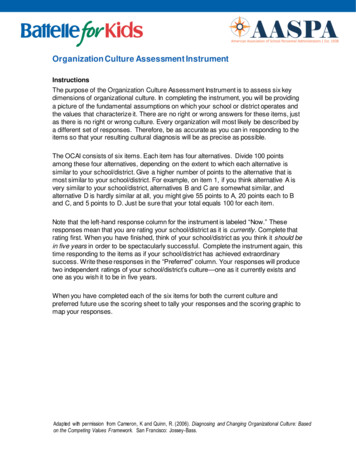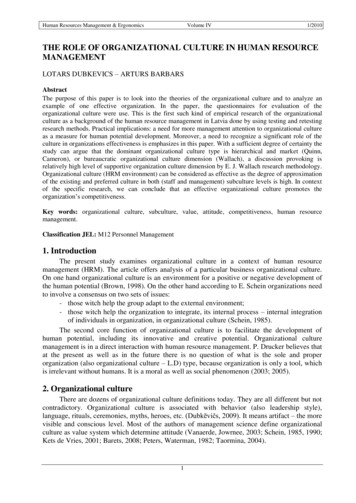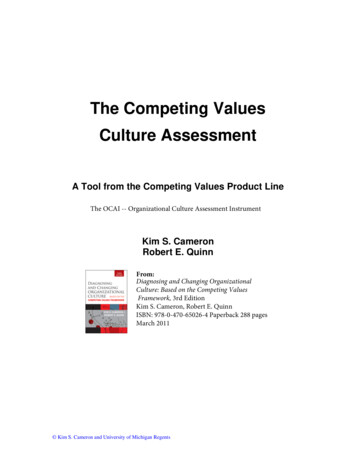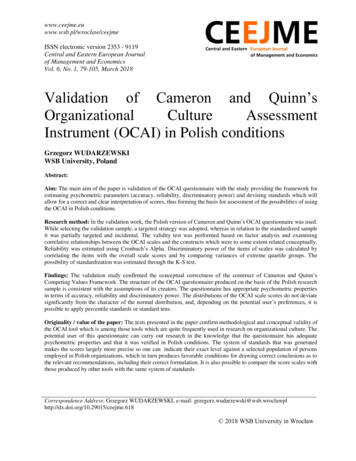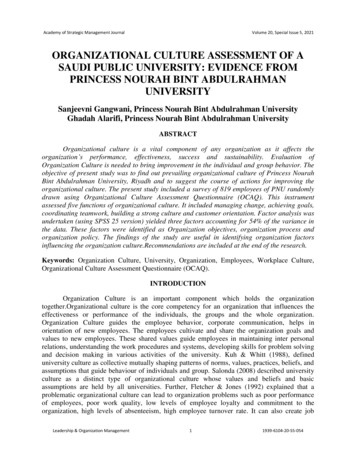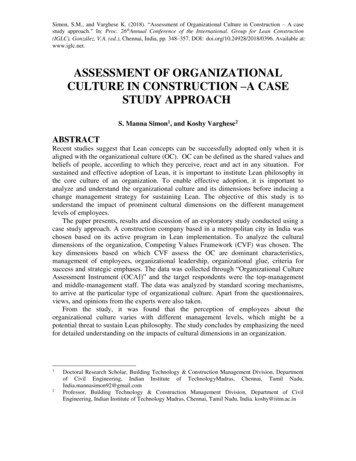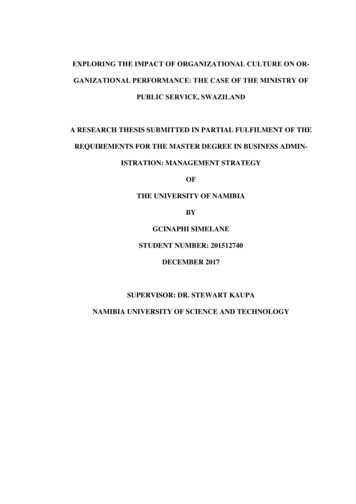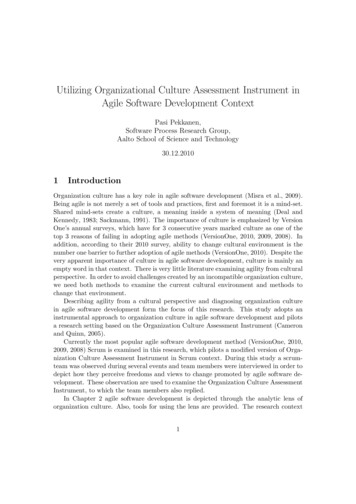
Transcription
Utilizing Organizational Culture Assessment Instrument inAgile Software Development ContextPasi Pekkanen,Software Process Research Group,Aalto School of Science and Technology30.12.20101IntroductionOrganization culture has a key role in agile software development (Misra et al., 2009).Being agile is not merely a set of tools and practices, first and foremost it is a mind-set.Shared mind-sets create a culture, a meaning inside a system of meaning (Deal andKennedy, 1983; Sackmann, 1991). The importance of culture is emphasized by VersionOne’s annual surveys, which have for 3 consecutive years marked culture as one of thetop 3 reasons of failing in adopting agile methods (VersionOne, 2010, 2009, 2008). Inaddition, according to their 2010 survey, ability to change cultural environment is thenumber one barrier to further adoption of agile methods (VersionOne, 2010). Despite thevery apparent importance of culture in agile software development, culture is mainly anempty word in that context. There is very little literature examining agility from culturalperspective. In order to avoid challenges created by an incompatible organization culture,we need both methods to examine the current cultural environment and methods tochange that environment.Describing agility from a cultural perspective and diagnosing organization culturein agile software development form the focus of this research. This study adopts aninstrumental approach to organization culture in agile software development and pilotsa research setting based on the Organization Culture Assessment Instrument (Cameronand Quinn, 2005).Currently the most popular agile software development method (VersionOne, 2010,2009, 2008) Scrum is examined in this research, which pilots a modified version of Organization Culture Assessment Instrument in Scrum context. During this study a scrumteam was observed during several events and team members were interviewed in order todepict how they perceive freedoms and views to change promoted by agile software development. These observation are used to examine the Organization Culture AssessmentInstrument, to which the team members also replied.In Chapter 2 agile software development is depicted through the analytic lens oforganization culture. Also, tools for using the lens are provided. The research context1
is described in Chapter 3. The research design and procedures are presented in Chapter4. Results of the study are show in Chapter 5. And finally Chapter 6 summarizes thisstudy.2Cultural PerspectiveAgility is a cultural phenomenon. This chapter first presents the analytic lens of organization culture in Section 2.1. Then agile software development is depicted throughthe concept of organization culture in Section 2.2. Section 2.3 presents research approaches used to examine organization culture and in Section 2.4 one such method, theOrganization Culture Assessment Instrument, is presented in detail.2.1Organization CultureThe word and concept of organization, as well as organization culture, has multiplemeanings. In this research organizations are viewed as ”socially constructed systemsof meaning” (Barley, 1983). Sackmann (1991) presents culture as ”beliefs commonlyheld by a group” and Deal and Kennedy (1983) as a set of common assumptions, beliefs,artifacts, and language patterns that are passed from generation to generation. However,Ajiferuke and Boddewyn (1970) note that there are as many meanings to the word cultureas there are people using the word.The ambiguity in the concept of culture is also present in the concept of organizationalculture, as it is based on the former. However, as organizations are socially constructedsystems of meaning, organization culture consists of the shared meaning. Schein (1984)defines organization culture asthe pattern of basic assumptions that a given group has invented, discovered,or developed in learning to cope with its problems of external adaptation andinternal integration, and that have worked well enough to be considered valid,and, therefore to be taught to new members as the correct way to perceive,think, and feel in relation to those problems.In the center of this definition are the underlying basic assumptions, which Deal andKennedy (1983) describe as ”the way we do things around here”. The basic assumptions,the deeply shared meanings, are taken for granted and thus are not present in individualsawareness (Schein, 1984).Schein (1984) builds values on top of the basic assumptions, and manifestations ofa culture on values. This three-tier-model is presented in Figure 1. Only very little ofthe culture is visible above the waterline, most of it remains submerged for the nakedeye. Sackmann (1991) provides a metaphor for understanding the importance of culturalvalues and basic assumptions: pyramids can be found in Egypt and Mexico, but theyserve in two very different meanings. Ones were used as tombs and the others forworshipping the sun. Without knowledge of the values and basic assumptions, it isimpossible to decipher the actual meaning.2
Visible, hardto table and EspousedGreater Levelof AwarenessUndebatable, Taken for GrantedBasic AssumptionsTaken for GrantedRelationship to EnvironmentNature of Reality, Time and SpaceNature of Human NatureNature of Human ActivityNature of Human RelationshipsFigure 1: Organization culture as an iceberg. Adapted from Schein (1984) and Sackmann(1991).In addition to ambiguity of organization culture, it is often confused with corporateculture. According to Sathe (1983) corporate culture can mean unit or division culturein addition to the culture shared by the whole company. Taking that viewpoint into account, the confusion is unsurprising. As this research defines organization independentlyfrom a company, the term corporate culture should not be confused with organizationculture in the context of this study.Management studies often mention united and strong company cultures. Martin(1992) presents three different views to organization culture: integration, differentiationand fragmentation. Integration view assumes that an unified culture exists. Differentiation view acknowledges the existence of multiple subcultures and fragmentation viewquestions the existence of any shared culture.(Martin, 1992)3
2.2Agile Software Development as Cultural ConceptResponding to change and creating change for others to change is a central idea of different software development methods placed under the term agile software development(Highsmith, 2002). Ability to respond to change requires many levels of freedom (Boehmand Turner, 2003). These two concepts, change and freedom, are also reflected in theAgile Manifesto1 , which states that responding to change is valued over following a planand that individuals and interactions are valued over processes and tools.Following the idea of the Agile Manifesto this research utilizes a competing valuesapproach to study agile software development from a cultural perspective. In orderto reach competing values for adapting to and creating change and many degrees offreedom, this study turns into finding opposite values. Adapting to and creating tochange is contrasted with merely following a long-term fixed plan and many degrees offreedom with external organizational control.This study focuses on the Scrum-process (Schwaber and Beedle, 2002), where theworking environment is highly team oriented. According to Schwaber and Beedle (2002),Scrum software development teams should be self-organizing. Moe et al. (2008) connectthe concept of self-organizing in Scrum-process to different levels of autonomy, whichfall under the concept of many degrees of freedom in this research. Autonomy occurs indifferent levels of an organization, organizational level, team level and individual level, touse the distinction used by Moe et al. (2008). van Mierlo et al. (2006) further examinethe constructs of autonomy in different levels of the organization and find that theseconstructs are interlinked. They state that team level autonomy and individual levelautonomy are not equal as constructs, but isomorphic.Figure 2: Analytical perspectives.The different organizational levels, from the concept of autonomy, bring the secondanalytical perspective to this study. As organization culture is used as a lens to studywhat shared meanings, artifacts and values are associated with competing values, theseitems can be shared with different levels of the organization. Thus, the interest focuseson how team’s members see their own team and the organization around that team.This view is illustrated in Figure 2. Furthermore, is the culture integrated over different1http://agilemanifesto.org/ accessed 16.12.2010.4
teams in the organization or do different teams have separate cultural views to theorganization, in the sense as Martin (1992) introduces different views to culture. Also,do teams have distinctive internal cultures and how similar or different are the team levelcultures between different teams. This discussion is closely linked with multiple levels offreedom and embracing change, which allows distinctive cultures to form. Organizationculture offers a powerful analytical lens to the mentioned questions as shared meaningsof different objects and concepts are on the focal point of culture.2.3Examining Organization CultureAs culture consists of unconscious components, it is difficult for an outsider to decipherit. This raises the question how such an elusive phenomenon can be examined. Ouchiand Wilkins (1985) divide empirical work in the domain of organization culture into treecategories: holistic studies, semiotic or language studies and quantitative studies. Holistic studies, according to Ouchi and Wilkins (1985), follow the ethnographical traditionof Radcliffe-Brown (1952) and Malinowski (1978). van Maanen (1973) is an example ofthis category with his ethnographic study of a police organization.Barley (1983), in his semiotical study of a funeral home, depicts the semiotic traditionas study of signs and systems of signs. Semiotics concerns the principles by whichevents, words, behaviors and objects carry meaning to the community (Barley, 1983).He gathered information with a multitude of interviews and observations, and analyzedthe meaning of previously mentioned targets of signification. Geertz (1994) uses the termthick description of an ethnographical form that is extremely sensitive to symbols, totheir context and to how they are interpreted. The objective of the semiotical approachis to gain access to the conceptual environment in which the subjects of the study livein and have an ability to converse with them (Geertz, 1994). Ouchi and Wilkins (1985)note qualitative studies by presenting the usage of surveys and content analysis methodsin organization culture studies.Holistic studies, based on ethnographical methods, are very time-consuming and thushard to apply for diagnosing current organization culture. Even though semiotic studies,as Geertz (1994) shows, can make use of an ethnographical or ethnomethodologicalapproach and can be subjected to the same criticism as holistic studies in terms of timeconsumption, they can also be carried in less time consuming way as Barley (1983)shows. In terms of time consumption, or to be more exact, fieldwork time consumption,a questionnaire based approach provides a convenient way. One questionnaire-basedmethod is examined more in Chapter 2.4. However, it should be noted that levels ofanalysis can be vastly different between questionnaires and Geertz’s thick description.Ouchi and Wilkins (1985) also report studies using a mixed-method approach, whichcombine quantitative and qualitative instruments in examining organization culture.2.4Organizational Culture Assessment InstrumentCameron and Quinn (2005) present an Organizational Culture Assessment Instrument(OCAI) for examining organizational culture by using a survey. The OCAI is a question5
naire based instrumentalization of the Competing Values Framework (CVF) by Quinnand Rohrbaugh (1983). The CVF was originally created as an organizational effectiveness criteria. According to Quinn and Rohrbaugh (1983), it contains three dimensions.The first dimension, the horizontal axis, divides organizational focus by contrasting internal dynamics orientation against outward external environment orientation. The seconddimension, the vertical axis, consists of organizational preference to interest in stabilityand control in contrast with flexibility and change. The third dimension contrasts meansand ends, processes versus final outcomes. However, the OCAI does not utilize the thirddimension and thus the OCAI has internal versus external and control versus stabilitydimensions (Cameron and Quinn, 2005). (Quinn and Rohrbaugh, oraleCohesionExtended hipTemporary teamsExternal FocusInternal ilityPerformanceHierarchyControlMarketFigure 3: Visual characterization of the OCAI, adopted from Cameron and Quinn(2005), Goodman et al. (2001), Helfrich et al. (2007), Kalliath et al. (1999), Quinnand Rohrbaugh (1983) and Quinn et al. (1991).The two dimensions of the OCAI define four quadrants. Cameron and Quinn (2005)name these quadrants clan, adhocracy, market and hierarchical cultures. These culturalcategories are illustrated in Figure 3, along with a brief categorization of each culturaltype. A hierarchical culture emphasizes formal coordination, centralized decision making and authority. It values stability and predictability. Rigorous, precise, predictable,organized and clear can be used to describe a hierarchical culture. A market cultureemphasizes productivity, efficiency, measurable outcomes and clear goals. An adhocracy6
culture emphasizes growth, innovation, flexibility, risk taking, commitment and being inthe leading edge. An adhocracy culture creates a dynamic, creative and entrepreneurialworkplace. Individual initiative and freedom are also valued. A clan culture, or sometimes called a group culture, is a friendly palace where people share a lot of themselves.Broad participation, teamwork, consensus, decentralized decision making and loyaltyare parts of a clan culture. Human resource development is an integral focus of a clanculture. (Cameron and Quinn, 2005; Helfrich et al., 2007; Goodman et al., 2001; Quinnet al., 1991; Zammuto and Krakower 1991 via Goodman et al. 2001)As each of these cultures is embedded in a particular set of competing values thecultures are polar-opposites with contrasting emphases (Quinn and Rohrbaugh, 1983).This polar-opposite setting illustrates conflicts or competing values of organizationallife, we want organizations to be adaptive and flexible, but at the same time stableand controlled (Quinn et al., 1991). In such highly polarized view it has to be notedthat the cultural types are not mutually exclusive. On the contrary, these opposites aremutually existing (Quinn et al., 1991). Goodman et al. (2001) mark that the framework”makes it explicit that an organization needs to embrace elements of each of the fourcultures.” Moreover, Quinn (1990, via Goodman et al. (2001)) notes that overemphasison particular culture can cause organizational dysfunctionality.3Study ContextThe studied Scrum-team was part of a mid-size software company. The company hadmultiple internal units which are here called departments. The studied scrum team waspart of one of these departments. The department had also other Scrum-teams andother teams, as did the other departments. The studied team had a past of ratherindependent team working on niche products, but it was also in close communicationwith other teams within that department as well as with teams from other departments.The team consisted of 8 people engaged in software development and testing activities, 2 product owners and one team manager. The team had recently, 2 weeks beforethis study began, undergone an internal change. For nearly two years they had workedas internally two separate teams, but now they had joined their efforts. Before workingas internally separate teams they had been working as one single team for a long period.All of the team members had a long experience with agile software development methodsand they all had ScrumMaster training. The respondents had worked on average 3.9years within the current team and 6.3 years within the company.4Research MethodsThe focus of this study is to be a descriptive case study (Yin, 1994) as the purpose ofthis study is both to uncover perceptions of agile software development and to pilot theresearch design. A single-case design (Yin, 1994) was used to approach this focus. Thecase study included a survey (Section 4.1), interviews, (Section 4.2), and observations,which are explained in Section 4.3.7
4.1SurveyA link to an electronic survey form was sent to the members of the studied team. A totalof 11 invitations to participate the survey were sent. The survey consists of five sections.The first section gathers background information of how long the respondents haveworked in the company, in their current team, the name of their current team and theirposition in the team or organization. The second section contains the OCAI questionsand examines the current organizational culture setting. The statements were taken aspresented by Cameron and Quinn (2005) and are presented in Appendix A. The thirdsection consists of 5-point Linkert scale statements and two open ended questions. Thestatements capture respondents views on agile software development and are presentedin Appendix B. The fourth section contains the same statements as the third section, butthe context is an ideal agile software development organization, instead of the currentorganization. The fifth, and final, section contains two open-ended questions whichcollect information of the organizational context.Means for each of the OCAI statements were calculated and combined to four subscales by further calculating means-of-means for first option of each question and so forthfor all 4 options. Cronbach’s alphas were calculated to test inter-item consistency withineach sub-scale (Nunnally et al., 1967). According to Nunnally et al. (1967) a value of0.7 and above indicates acceptable validity for the sub-scales.The same procedure wasused both in current organizational culture and ideal organizational culture for agiledevelopment. Analytical procedures for OCAI data are explained in more detail byCameron and Quinn (2005). Two analytical contexts were used when analyzing theOCAI data, the product owners and team manager, and team members.The statements of agile software development, Section 3 in the survey, was used tocapture insight over three perspective. First, the section contains statements of freedom and change in agile software development in general. Second, there are team levelstatements of freedom and change, which aim to capture how individuals see their team.Third, statements concerning the organization have no specific definition whether organization means their current department or the whole company. This approach waschosen to gain possibility to examine the standard deviation of the statements and tocompare the results against those of the OCAI. Means, medians and standard deviations were calculated for the statements, but no multivariate analysis techniques wereemployed during this study.4.2InterviewsThe interviews were conducted in a semi-structured (Yin, 1994) manner. A total oftwo product owners, one team manager and six team members were interviewed. Theinterviews took place in the company premises and lasted from 20 minutes to over anhour. Eight of the interviews were made in Finnish and one in English.The interview transcripts were first read twice through to obtain a general levelunderstanding of the whole material. Next the transcripts where thematically encodedwith a purpose to find sections that describe views towards adapting to change and8
autonomy. Further on, narrative occurrences of common event, artifacts or objects weresearched with an objective of semiotic analysis.4.3ObservationsThe study began by observing three retrospective meetings and one sprint planningmeeting. The objective of this approach was to gain understanding of the organizationalenvironment, what the team was doing and what kind of issues they were currentlydealing with. This period lasted for three weeks in total and each meeting lasted fromone to two hours. After the initial period the team was observed in their team room forone and a half weeks, from 4 to 6 hours per day. In addition to the initial observationsone more sprint planning and retrospective were observed.The retrospective meetings were recorded and are to be transcribed and subjectedto narrative and comparative analyses. However, in the context of this study the information gained through the observations is mainly used as a tool of interpretation.5FindingsThe findings of this study consist of two sources: the modified organizational cultureassessment instrument and qualitative observations. The findings of the first instrumentare presented in Section 5.1. Interview results are divided in two sections, to the view ofthe development team and to the view of product owners and team manager. The firstone is presented in Section 5.2 and the second one in Section 5.3.5.1Positioning a Scrum-team with a QuestionaireTable 1: OCAI results (N 10)ClanAdhocracyMarketHierarchyCurrent 50,852Ideal ,815Table 1 displays the general overview of all responses. Notable figures in the tableare Cronbach’s α coefficients for current clan culture and ideal proportion of marketculture. The especially low coefficient in current clan culture indicates that there hasbeen extreme variation. As a general finding it should be noted that currently the teamidentifies the organizational context first and foremost as hierarchical, while they seethat a mixture of clan and adhocracy would be the ideal situation.9
From Table 2 we can see that the participants agreed very strongly with the first fourstatements that describe the need of many levels of freedom in agile software development. They also agreed with the following three statements, though not that strongly,stating that the team has enough team-level freedom. The respondents did not see organizational control impeding their operations, collaboration with stakeholders and otherteams was not regarded completely without problems.The data in Table 2 also shows that the team sees adapting to change and continuous improvement very important, while creating change for others to adapt is seenrather neutral. The fourth section statements shows that the team feels they improveand evaluate their practices continuously, while at the same time maintaining enoughstability.FlexibilityClanAdhocracyExternal FocusInternal FocusHierarchyControlMarketFigure 4: Team members. (N 7)The team, only developers and testers, no product owners or team manager, hasrather different perspectives of current organization culture in their department and anideal organization culture in agile software development. This difference is illustrated inFigure 4. In ideal situation they value flexibility and balance between internal and external focus. Where as currently they see that the division has a hierarchical orientationwith a slight shift towards internal focus.10
11Table 2: Statements of agile software development (N 10)StatementAbility to define work practices within the team is a central part of agile software development.Ability to define and resolve problems within the team is a central part of agile software development.Ability to operate as a self-organizing team (self-organization within the team) is a central part of agile sw. dev.Organizational culture that emphasizes collaboration and teamwork is central to agile software development.We as a team have enough organizational freedom to define our work practices and methods.We as a team have enough organizational freedom to define and resolve problems.We have enough organizational freedom to work as a self-organizing team.Current organizational culture emphasizes collaboration.Collaboration with other teams is easy.Collaboration with different stakehodels (individual stakeholders who are not part of your team) is easy.Our organization places too much control over our team.Our organization impedes our team from functioning in an agile manner.Current organizational culture emphasizes individualism.Adapting to external change is central in agile software development.Agility is first and foremost about creating change for others to adapt to.Continuous process and technical improvement is central to agile software development.We as a team change our work practices and methods when we see a need to do so.We as a team create change for other to adapt, instead of merely adapting to change created by others.We as a team continuously evaluate our work practices and methods.We as a team continuously attempt to improve our work practices and methods.Current organization culture supports our team in working in a changing environment.Current organizational rules and policies prevent our team from implementing changes that we see necessary.Our team does not have enough stability.Our team lives in a continuous change that creates a nonsupporting working NoNoNoNoNoNoNoYesYesYes
ClanAdhocracyHierarchyMarketFigure 5: Product owners and team manager. (N 3)Product owners and team manager on the other hand, Figure 5, have a differentperspective than the team. According to them current and ideal situations are quitenear each other, with only a slight shift from hierarchy towards adhocracy culture. Thepreference of flexibility over control is not as clear as it is with the team members. Inaddition, where the team members are balanced between internal and external focus,the product owners and team manager slightly prefer internal orientation.5.2Team Members PerspectivesAll team members share the same perspective that the team has a lot of freedom andhas been functioning in a rather autonomous way. They mentioned different contextsfor the autonomy: work practices, tools, development directions for the software andtechnical decisions. The most coherent perspective was in the context of work practicesand tools, some did not even mention it without explicit questions as they took it forgranted in their team. In addition, freedom to choose tools and work practices wasthe most important one according to team members. One interviewee described that”we live in our own bubble”, another stated ”we have been kinda independent from the12
rest of the organization” and many stated that the team has a lot of freedom in theorganization.A team member explained the origins of the autonomy by stating:In the beginning everyone had a little bit of a feeling that do we dare to dothese things by ourselves. Then when [we] got more courage and steppedoutside the circle that one had drawn on the ground for himself, lets do andimplement by ourselves. Let’s not wait for [a support functionality].Another one acknowledged that the organization in fact does place a lot of limitations,but despite those limitation they have chosen their own way:if we like wanted to do everything the same way the others do, we wouldapparently have quite a lot of limitations.Those who talked about origins of the team’s freedom shared the same idea that theorganization had not explicitly given the team special freedoms, they simply beganoperating in their own way.However, while a few stated that ”who wouldn’t like freedom”, many felt that theorganization did not care about what they do. One interviewee stated:Now it feels sometimes a bit like it doesn’t matter what we doWhile an other interviewee thought that the lack of interest is only an idea shared withinthe team:we have always had an impression that nobody cares what we do, but on theother hand as our team has a reputation of being a very good team, or likethat, then apparently to some extent people are interested and following us.The team has received feedback from their customers, but some of the team membersdoubted their importance to the organization. However, the doubt was not totallyshared, some rationalized that silence can also be a good thing; ”I guess we have donesomething right”. Also, they wanted to be a more integral part of the organization, atleast on an individual level. One team member explained how the importance of theitems that his team is doing seems in the company perspective:Organization always goes like it’s that [their team name], we don’t want towaste any valuable resources on that.The content of their work was a common explanation for the lack of organizationalfeedback, or as one interviewee expressed that there were bigger fires burning aroundthe building.When asked how the organization could show more interest on the items that theteam works on, many started balancing between autonomy, control and feedback. Onedeveloper stated:13
Of course the risk is that when the organization gets more interested, theyget more nosy and try to control you more.All of the interviewed team members agreed that feedback would be a notion of organizational importance.The team’s departmental environment had not changed
a research setting based on the Organization Culture Assessment Instrument (Cameron and Quinn, 2005). Currently the most popular agile software development method (VersionOne, 2010, 2009, 2008) Scrum is examined in this research, which pilots a modi ed version of Orga-nization Culture Assessment Instrument in Scrum context. During this study a .


